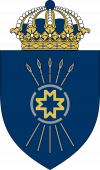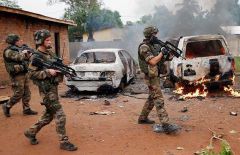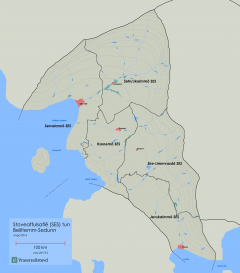Sedunnic Armed Forces (Pacifica): Difference between revisions
>Qwert No edit summary |
>Qwert No edit summary |
||
| Line 95: | Line 95: | ||
The Supreme Commander leads the Headquarters of the Armed forces, which consists of two staffs: the Operations Command, which plans, directs and controls the usage of the forces, and the Training Command which controls recruitment and training of the personnel in the forces. There are four service branches in the Sedunnic Armed Forces: the Army, the Navy, the Air Force, and the Teleresources. Each service branch has their own operations commands and regional training commands. The Special Forces, the Military Intelligence Service, the Military Materiel Agency and War Research Agency also belong to the Armed Forces and answer directly to the Headquarters. | The Supreme Commander leads the Headquarters of the Armed forces, which consists of two staffs: the Operations Command, which plans, directs and controls the usage of the forces, and the Training Command which controls recruitment and training of the personnel in the forces. There are four service branches in the Sedunnic Armed Forces: the Army, the Navy, the Air Force, and the Teleresources. Each service branch has their own operations commands and regional training commands. The Special Forces, the Military Intelligence Service, the Military Materiel Agency and War Research Agency also belong to the Armed Forces and answer directly to the Headquarters. | ||
Defence of the Sedunnic territory is coordinated with the six [[Authority coordination regions (Sedunn) (Pacifica)|authority coordination regions]] where military and civilian efforts are combined under the concept of ''total defence''. | Defence of the Sedunnic territory is coordinated with the six [[Authority coordination regions (Sedunn) (Pacifica)|authority coordination regions]] where military and civilian efforts are combined under the concept of ''total defence''. | ||
== Army == | == Army == | ||
Revision as of 17:05, 22 March 2020
| Sedunnic Armed Forces | |
|---|---|
| Rammstovd | |
 Coat of arms of the Sedunnic Armed Forces | |
| Founded | Antiquity |
| Current form | 2014 |
| Service branches | |
| Headquarters | Essela (peacetime) |
| Leadership | |
| Commander-in-Chief | Sedunnic Government |
| Minister of Defence | Derrns Kappsaty |
| Supreme Commander | General Maks Fejellienn |
| Manpower | |
| Military age | 18 |
| Conscription | 11-month service obligation |
| Active personnel | 71,000 |
| Reserve personnel | 265,500 |
| Deployed personnel | 20,000 |
| Expenditures | |
| Budget | $35.25 billion (2017) |
| Percent of GDP | 4.4% of GDP (2017) |
| Industry | |
| Domestic suppliers | STT Levē Kallnhē Botna SG SLU Sedtrē ASA |
| Foreign suppliers | Karnetvor Resentine |
The Sedunnic Armed Forces (Sedunnic: Rammstovd, literally "the War Authority") is the government agency that forms the military of Sedunn. It has four service branches: Army, Navy, Air Force, and the so-called Intelligence branch.
Military service is mandatory in Sedunn for both men and women, but after several reforms in the 1980s, each year only a minority is conscripted for training after the mandatory entrance assessment tests. Serving abroad is always voluntary in peacetime.
The active force is about 71,000 military and civilian voluntary personnel. The reserve force is about 265,500 and has both conscripted and voluntary personnel. The voluntary personnel of the reserve force mainly serves in local defence battalions.
Most of the equipment is manufactured domestically by state-owned companies. Military funding is by tradition high.
Mission and doctrine
The purpose of the Sedunnic Armed Forces is to prevent a foreign occupation of Sedunn and secure its continuing existence as an independent nation by defending the nation, its allies, and its interests in the world, and to assert the territorial integrity of Sedunn and the rule of international law. Furthermore, it shall keep the cross-Pacific trade routes open, support the civil society in case of natural disasters, and support international peacekeeping efforts.
The Sedunnic Armed Forces pursues a doctrine of high mobility, modularity, and often sophisticated equipment. The goal is to gain and maintain overwhelming local fire superiority by the means of combining arms. The ability is seen as a key component to achieve war deterrence. Especially the Navy is also used in access/area denial missions.
Following Tasternine's declaration of independence from the then nationalist Karnetvor in 2009 and King Vimmru II's new foreign policy where military neutrality was abolished, work has begun to increase expeditionary capabilities after decades of planning towards home defence. Sedunn has issued a guarantee of independence to Transsuneria and has generally reassumed a more active role internationally and militarily.
Current international deployments

The Sedunnic Armed Forces has deployed expeditionary forces in Reizen of an estimated size of 18,000 troops as part of a agreement between Sedunn, the Frost Empire, the WPR and the RDC. Sedunn promised a saturation attack against RIM targets and follow-up land operations in exchange for the parties returning to the Grovne Ceasefire.
The operation was proceeded by a deployment of its Special CBRN Operations Units in Reizen to prevent or limit the use of chemical weapons by the RIM. By mid-February this year an estimated 25% of the RIM's stockpile had been destroyed.
The Sedunnic Armed Forces also has peacekeeping troops deployed in Transsuneria since the end of the Second Transsunerian Civil War. The number of troops has recently been reduced to a battalion-sized permanent contingent which is tasked with aiding the Transsunerian maintain peace and to protect the Sedunnic naval support base in Floodport. According to current planning, a motorised battalion, a detachment of two to four Hotvemm G84 fighters and a small naval logistics support unit shall be deployed by the end of 2020 the earliest.
The Sedunnic Navy conducts patrol missions on the cross-Pacific trade routes. Sedunn has small naval logistics support units in its allies Karnetvor and Resentine.
Recruitment

Military (or civilian) service is compulsory from the age of 18 for all men and women (women since 2017). When turning 17, all Sedunnic citizens take entrance assessment tests (that may be postponed up to the age of 20 under special circumstances). Based on the results, different service alternatives are offered, of which one has choose one. The training is normally at least seven months. While many still are conscripted, the yearly number of conscripts has been greatly reduced since the 1980s, more due to modernisation requiring less personnel than an actual disarmament.
After having completed the training, the recruits are given a choice to continue serving in a professional career in one of the active units, or join the reserve (the so-called mobilisation forces). Personnel that belongs to the reserve are required to participate in recurring refresher training and exercises.
After having reached the upper military age, which varies depending on type of service, career personnel and reservists may volunteer to join the local defence forces.
In total, about 2.1% of the population is directly engaged in Sedunn's military defence (about 336,000 personnel), of which 32% serve voluntary units. About 12% are female.
Organisation

The highest ranking officer in the Sedunnic Armed Forces is the Supreme Commander, currently General Maks Fejellienn. The Supreme Commander is appointed by the Sedunnic Defence Ministry and leads the Armed Forces according to the policy set forth by the Government.
The Supreme Commander leads the Headquarters of the Armed forces, which consists of two staffs: the Operations Command, which plans, directs and controls the usage of the forces, and the Training Command which controls recruitment and training of the personnel in the forces. There are four service branches in the Sedunnic Armed Forces: the Army, the Navy, the Air Force, and the Teleresources. Each service branch has their own operations commands and regional training commands. The Special Forces, the Military Intelligence Service, the Military Materiel Agency and War Research Agency also belong to the Armed Forces and answer directly to the Headquarters.
Defence of the Sedunnic territory is coordinated with the six authority coordination regions where military and civilian efforts are combined under the concept of total defence.